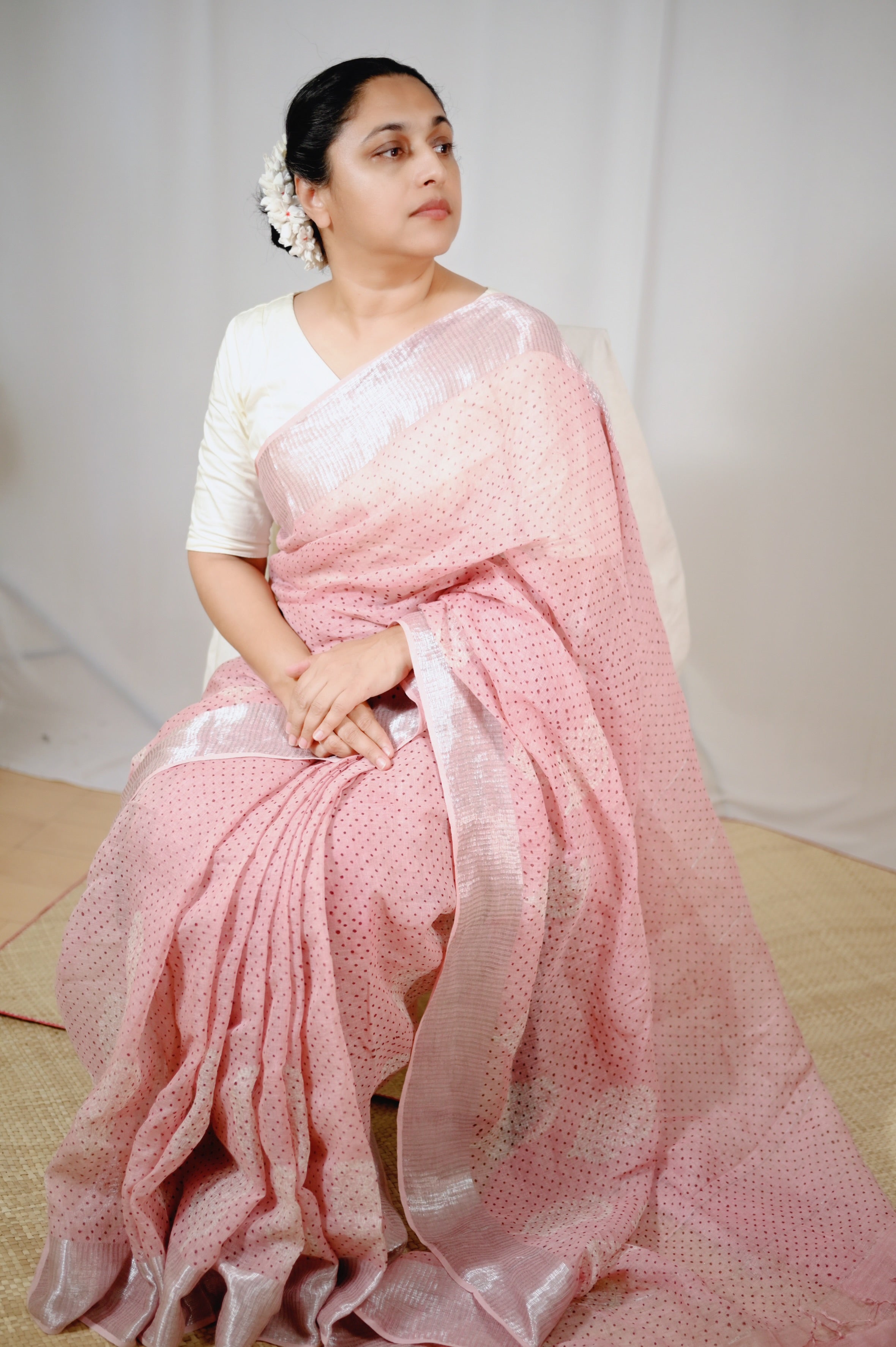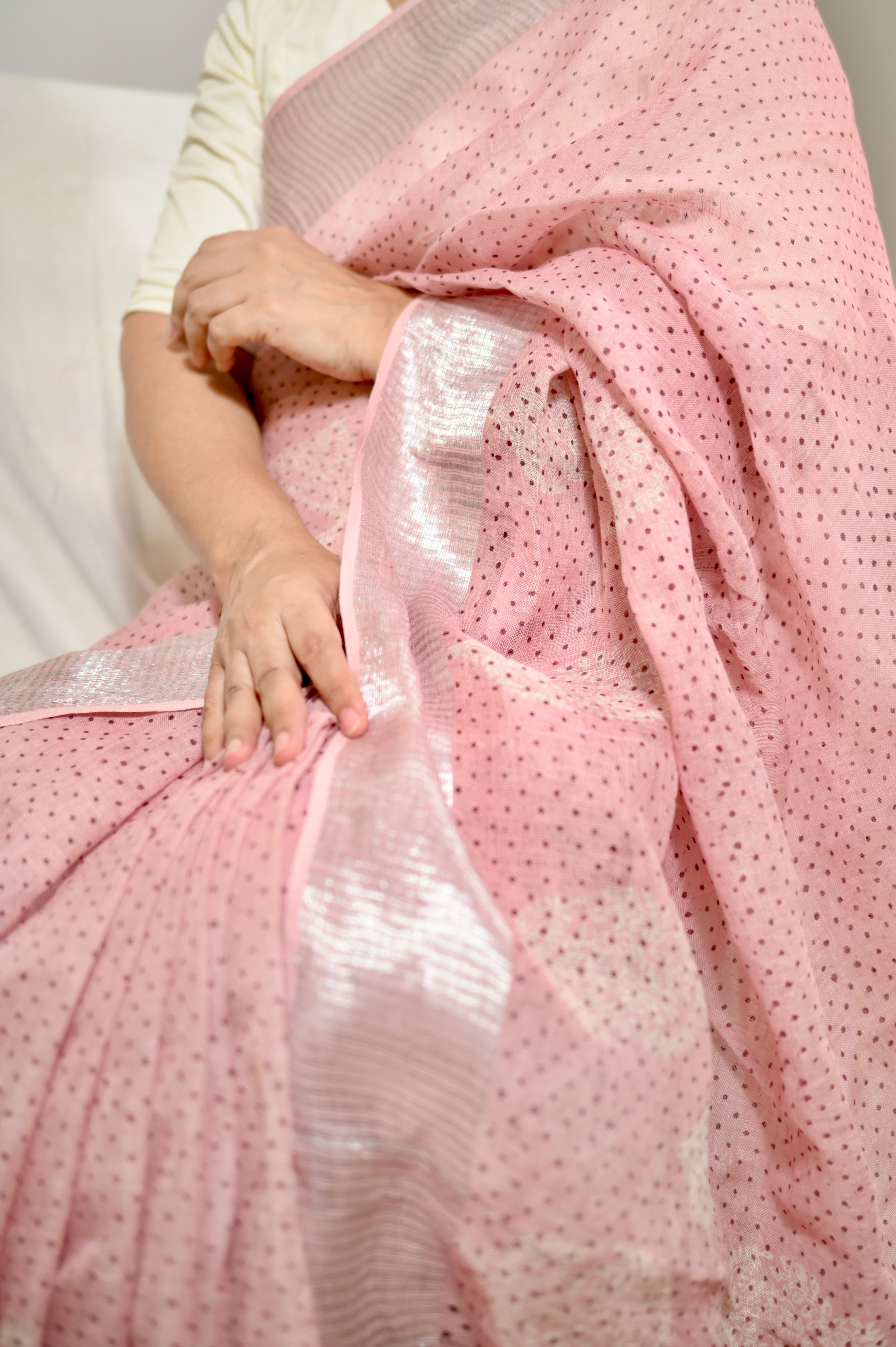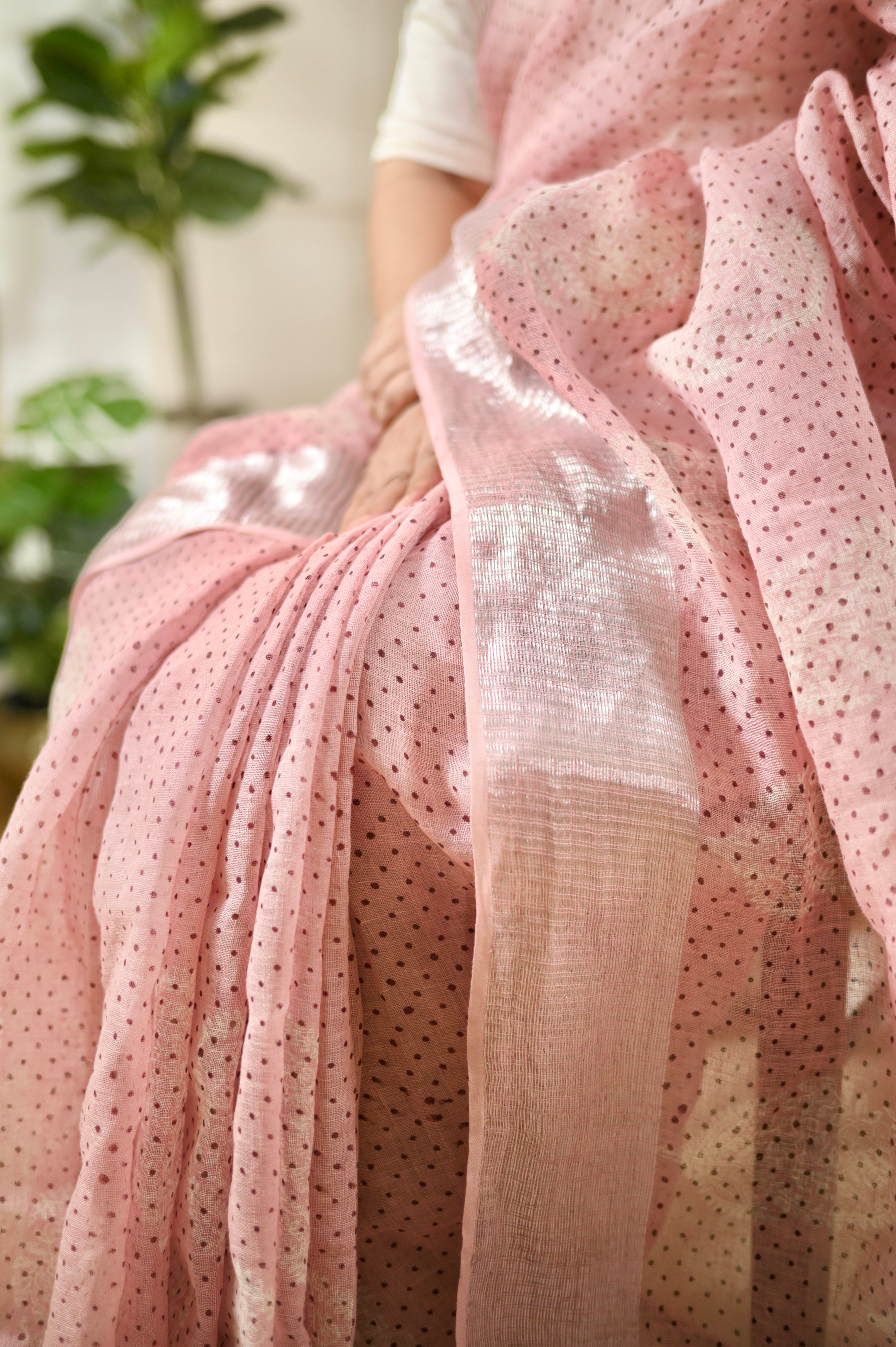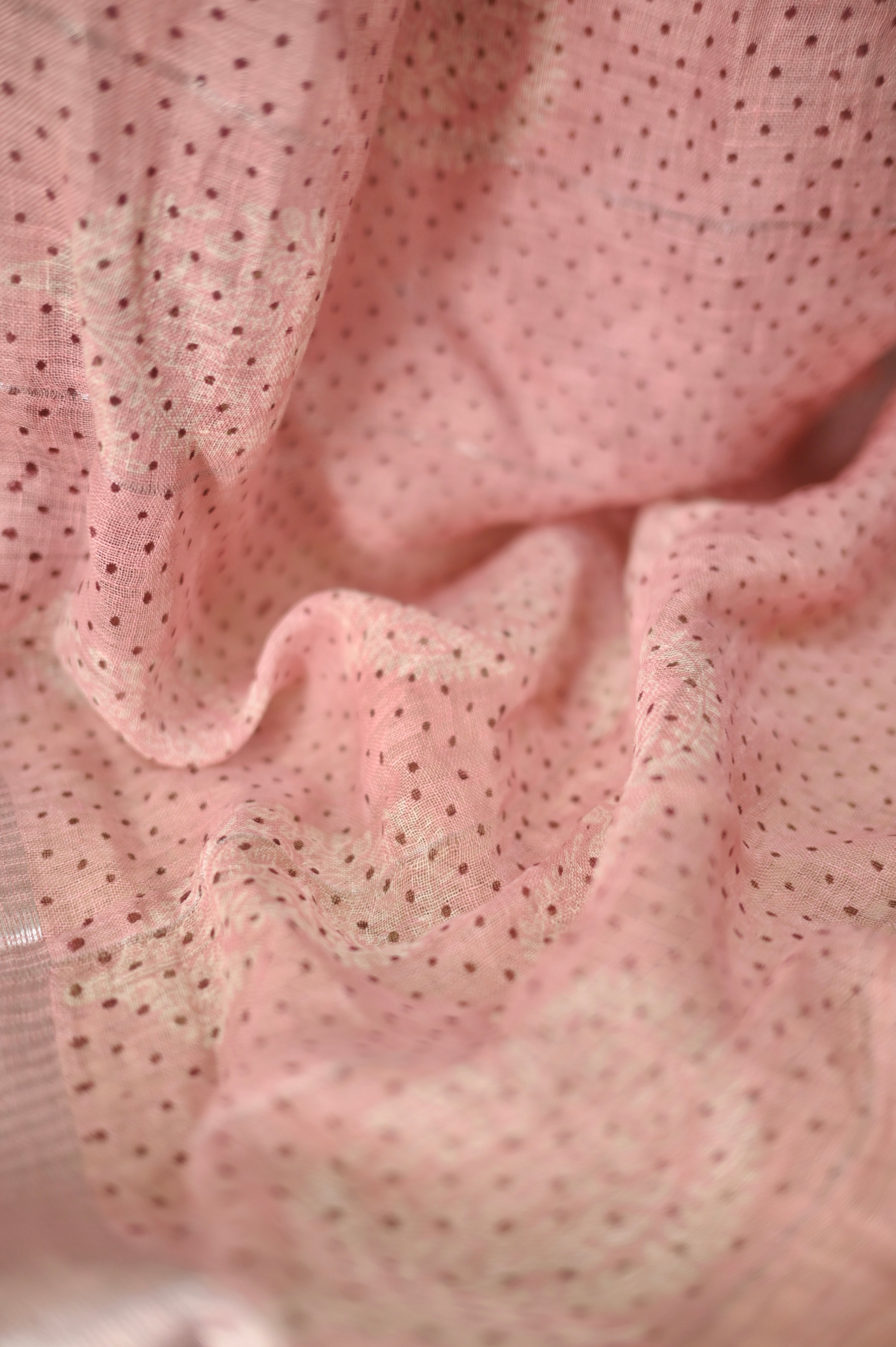



LEA
- Description
- Perspective
Mud resist printed, loosely handwoven linen sari (80lea)
Handwoven in Bhangalpur & handprinted in Bagru.
LINEN: Steeped in human history
Recent discoveries in a prehistoric cave in the Republic of Georgia demonstrate that flax fibres were utilised by humans as far back as 30,000 B.C. Linen stands as one of humanity's earliest and most revered textiles, prominently featured in Hindu scriptures that underscore its profound significance in ancient Indian civilizations. Its rich history spans from 12000 B.C. during the Vedic age to 1500 CE in the Medieval period, while Egyptian mummies, too, were wrapped in this extraordinary fabric.
On the momentous occasion of Rama's coronation as Prince of Ayodhya, he and the royal courtiers donned exquisite linen garments. Furthermore, ancient texts highlight Krishna adorned in a striking yellow linen uttariya, showcasing the fabric's cultural importance.
Linen Production and Impressive Characteristics
Linen, derived from the fibres of the flax plant (linseed), is celebrated for its exceptional strength, outstanding absorbency, and remarkable versatility. The legacy of Indian handloom weaving dates back to the Indus Valley Civilisation, and Indian textiles have historically been highly coveted across Rome, Egypt, and China.
Masterful Spinning Process: Linen is spun in water heated to precisely 60°C (140°F), ensuring smooth fibre separation that yields fine threads. As part of an eco-conscious approach, bleaching is carried out using environmentally friendly peroxide rather than harmful chlorine.
Producing high-quality linen is more labour-intensive than that of other fabrics, requiring meticulous care in harvesting, where stalks are cut close to the roots to extract superior fibres.
Bhagalpur: The Epicentre of Linen Weaving Excellence
Bhagalpur, situated along the fertile banks of the Ganges River east of Varanasi, is lauded as the premier destination for exquisite linen and silk handlooms. Boasting a weaving tradition that spans over 100 years, this region is home to approximately 30,000 skilled artisans working diligently across 25,000 handlooms. The humidity in Bhagalpur is ideal for crafting superior textiles, which contributes to their renowned quality.
In recognition of its rich heritage, Bhagalpur was awarded a Geographical Indication (GI) tag in 2013, thereby solidifying its status as a cultural treasure. Women play an indispensable role in this weaving legacy, excelling in both spinning and weaving, which enhances the artistry and craftsmanship.
Bhagalpur's unique ability to weave linen at any GSM (grams per square meter) positions it as a leader in global textile production. Employing traditional techniques with charkha and pit looms, artisans create textiles characterized by distinctive patterns and textures. The use of natural dyes not only elevates the visual appeal but also ensures sustainability.
The GI tag has further amplified Bhagalpur's reputation, making its linen and silk products highly sought after by connoisseurs and future generations alike, who recognize the value of handcrafted heritage textiles.
Linen is often regarded as a luxurious choice, commanding a higher price than cotton due to its intricate production process. Its ability to be cross-dyed opens a world of possibilities for stunning, vibrant colour effects even before weaving.
Varieties of Linen Based on Weaving Patterns:
- Damask linen
- Twill weave linen
- Herringbone linen
- Closely-woven linen
- Plain woven linen
- Loosely woven linen
Choose options




- Description
- Perspective
Mud resist printed, loosely handwoven linen sari (80lea)
Handwoven in Bhangalpur & handprinted in Bagru.
LINEN: Steeped in human history
Recent discoveries in a prehistoric cave in the Republic of Georgia demonstrate that flax fibres were utilised by humans as far back as 30,000 B.C. Linen stands as one of humanity's earliest and most revered textiles, prominently featured in Hindu scriptures that underscore its profound significance in ancient Indian civilizations. Its rich history spans from 12000 B.C. during the Vedic age to 1500 CE in the Medieval period, while Egyptian mummies, too, were wrapped in this extraordinary fabric.
On the momentous occasion of Rama's coronation as Prince of Ayodhya, he and the royal courtiers donned exquisite linen garments. Furthermore, ancient texts highlight Krishna adorned in a striking yellow linen uttariya, showcasing the fabric's cultural importance.
Linen Production and Impressive Characteristics
Linen, derived from the fibres of the flax plant (linseed), is celebrated for its exceptional strength, outstanding absorbency, and remarkable versatility. The legacy of Indian handloom weaving dates back to the Indus Valley Civilisation, and Indian textiles have historically been highly coveted across Rome, Egypt, and China.
Masterful Spinning Process: Linen is spun in water heated to precisely 60°C (140°F), ensuring smooth fibre separation that yields fine threads. As part of an eco-conscious approach, bleaching is carried out using environmentally friendly peroxide rather than harmful chlorine.
Producing high-quality linen is more labour-intensive than that of other fabrics, requiring meticulous care in harvesting, where stalks are cut close to the roots to extract superior fibres.
Bhagalpur: The Epicentre of Linen Weaving Excellence
Bhagalpur, situated along the fertile banks of the Ganges River east of Varanasi, is lauded as the premier destination for exquisite linen and silk handlooms. Boasting a weaving tradition that spans over 100 years, this region is home to approximately 30,000 skilled artisans working diligently across 25,000 handlooms. The humidity in Bhagalpur is ideal for crafting superior textiles, which contributes to their renowned quality.
In recognition of its rich heritage, Bhagalpur was awarded a Geographical Indication (GI) tag in 2013, thereby solidifying its status as a cultural treasure. Women play an indispensable role in this weaving legacy, excelling in both spinning and weaving, which enhances the artistry and craftsmanship.
Bhagalpur's unique ability to weave linen at any GSM (grams per square meter) positions it as a leader in global textile production. Employing traditional techniques with charkha and pit looms, artisans create textiles characterized by distinctive patterns and textures. The use of natural dyes not only elevates the visual appeal but also ensures sustainability.
The GI tag has further amplified Bhagalpur's reputation, making its linen and silk products highly sought after by connoisseurs and future generations alike, who recognize the value of handcrafted heritage textiles.
Linen is often regarded as a luxurious choice, commanding a higher price than cotton due to its intricate production process. Its ability to be cross-dyed opens a world of possibilities for stunning, vibrant colour effects even before weaving.
Varieties of Linen Based on Weaving Patterns:
- Damask linen
- Twill weave linen
- Herringbone linen
- Closely-woven linen
- Plain woven linen
- Loosely woven linen
Free delivery worldwide
Purchased products will be shipped out upon confirmation of payment from the payment gateway. We offer free shipping. Upon purchase, the product is dispatched in a minimum of 7 to maximum of 10 business days.
Urgent shipping within 2-5 days can be arranged at an additional charge based on the shipping location. The products will be delivered within a minimum of 3 and maximum of 10 working days. We only use professional and reliable courier services namely Delhivery, BlueDart and DHL for despach of our products.
Satisfied or refunded
Customers may return a product purchased from our online store within 2 days upon receipt of the product, only under below stated circumstances: 1. Visible defects or damages that affect its overall quality of the product. 2. Product received does not match the specifications as mentioned on our website. Please note that returns will not be entertained for reasons other than quality issues or specification mismatches. refunds approved will be creduted to the source account within a minimum of 3 working days and maximum of 7 working days. Read More
Top-notch support
We at Parvai are extremely focussed on providing the best possible support to our patron community. The Parvai customer support assures all our patrons details of what each product represents both in its tangible and non-tangible form - especially from a customer's point of view, from how it feels on the skin to its deep intrinsic value. We are ready to engage in detailed conversations about our product quality, process, people who made it and its perspective. Patrons can reach us at Parvai, HQ10, Primus Building, Door No: SP-7A, Guindy Industrial Estate, Chennai. 600032. Email: Enquiry@theparvaishop.com, Phone: +917358550888
Secure payments
We at Parvai prioritize the security and confidentiality of our customers' online transactions. To ensure a safe and secure payment experience, we have integrated the Razorpay payment gateway into our website. This declaration serves to inform our valued customers about the payment gateway we employ for all online payments. Razorpay is a trusted and industry-leading payment gateway that adheres to stringent security standards. It provides a secure infrastructure for processing online payments, employing advanced encryption technology and robust security protocols to protect sensitive financial information. Read More

